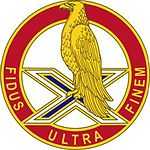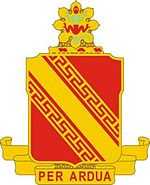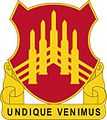38th Air Defense Artillery Brigade (United States)
The 38th Air Defense Artillery Brigade is an inactivated United States Army unit which provided air defense for South Korea. Based at Osan Air Base from 25 May 1961 until 31 July 1981, its last assignment was as a major subordinate command in the Eighth United States Army. It was initially formed as the 38th Artillery Brigade in 1918.
| 38th Air Defense Artillery Brigade | |
|---|---|
 | |
| Active | 1918–19, 1933–45, 1951–53, 1961–81 |
| Country |
|
| Branch |
|
| Type | Air defense artillery |
| Size | Brigade |
| Part of | Eighth United States Army |
| Garrison/HQ | Osan Air Base |
| Motto | "By Valor and Power" |
| Surface to air missiles |
MIM-23 Hawk MIM-14 Nike-Hercules |
| Decorations | Air Force Outstanding Unit Award |
| Campaign streamers | Normandy, Ardennes-Alsace, Rhineland, Northern France, and Central Europe |
| Insignia | |
| Distinctive unit insignia |
 |
History
World War I
The unit was constituted in June 1918 as Headquarters and Headquarters Company, 38th Artillery Brigade in Camp Eustis, Virginia (now Fort Eustis).[1] The unit later sailed to Brest, France and was assigned to Services and Supply. It remained there until the end of World War I when it returned to the United States for demobilization at Fort Monroe, Virginia in February 1919.[2]
Fourteen years later, in October 1933, the unit was reconstituted as Headquarters and Headquarters Battery, 38th Coastal Artillery Brigade.[3]
World War II
At the time of the United States' entry into World War II, the 38th Coastal Artillery Brigade was located in Camp Stewart, Georgia, (now Fort Stewart)[4] and was deployed in the European Theater.
It underwent another reorganization in September 1943, when it became Headquarters and Headquarters Battery, 38th Anti-Aircraft Brigade. The 38th Anti-Aircraft Brigade earned campaign streamers for participation in the Normandy,[5] Ardennes-Alsace,[6][7] Rhineland, Northern France[8] and Central Europe[9] Campaigns. At the end of the war (1945), the 38th Anti-Aircraft Brigade was inactivated in Germany.
Cold War
The brigade was re-activated in March 1951 at Fort Bliss, Texas, where it remained until inactivation in May 1953. At that time, the unit's personnel and equipment were transferred to the new 1st Guided Missile Brigade.[10]
The unit was re-designated as Headquarters and Headquarters Battery, 38th Artillery Brigade (Air Defense) on 20 March 1961, and with the assignment of air defense battalions and missile systems was activated in the Pacific area. The brigade was under the operational control of Commander, United States Air Force In South Korea and had operational command and control of U.S. and South Korean air defense forces in Korea.[11]
On 15 March 1972, the brigade was re-designated 38th Air Defense Artillery Brigade by way of the U.S. Army Combat Arms Regimental System. The brigade headquarters, along with the headquarters of the 314th Air Division and the Republic of Korea (ROK) Air Force were collocated at Osan Air Base.
The 38th Air Defense Artillery Brigade, along with the 1st Battalion, 2nd Air Defense Artillery Regiment was inactivated in July 1981 and its HAWK missile systems and associated "equipment held by the US units were transferred cost-free to the Republic of Korea Army, who assumed primary responsibility for that air defense mission.”[13]:iii
The only surviving battalion, "2nd Battalion, 71st Air Defense Artillery Regiment, whose sector covered the northern reaches of South Korea, was reassigned on 16 July 1981 to the US Army Elm [sic], Combined Field Army (ROK/US),[14] pending transfer of its weapon/equipment and missions to the Republic of Korea Army in mid-1982. On 31 July 1981, following over 20 years of air defense coverage for the Republic of Korea, the 38th Air Defense Artillery Brigade's Headquarters was inactivated at Osan Air Base. An enormously important task bearing directly on the security environment of the Korean Peninsula had been successfully completed."[13]:149
Inactivation ceremony brochure
| 38th ADA Brigade, Inactivation Ceremony, 15 July 1981, Osan Air Base, Korea | ||||||||||||||||||||||
|---|---|---|---|---|---|---|---|---|---|---|---|---|---|---|---|---|---|---|---|---|---|---|
|
Structure
At the time of its inactivation, the brigade comprised the following units:
 |
 |
 |
 |
 |
 |
| Headquarters & Headquarters Battery | 1st Battalion (HAWK), 2nd ADA[15]:33 redesignated from 7th Battalion (HAWK), 2nd ADA[15]:47 |
7th Battalion (HAWK), 5th Artillery Links: Hawk Missile B-7-5 |
2nd Battalion (HERC), 44th ADA redesignated from 4th Battalion (HERC), 44th ADA Links: Camp Echo Hill Military.com Site C-4-44 Korea |
1st Battalion (HAWK), 44th ADA redesignated from 6th Battalion (HAWK), 44th ADA Links: B-6-44 ADA Military.com |
2nd Battalion (HAWK), 71st ADA Links: Military.com Military.com |
Insignia
Shoulder sleeve insignia
- Description
Centered vertically on a shield 2 inches (5.08 cm) in width and 2 3/4 inches (6.99 cm) in height divided from upper left to lower right the upper portion red and the lower yellow with a 1/8 inch (.32 cm) border, a white gauntleted fist grasping a lightning bolt yellow above and red below.
- Symbolism
The partition line represents the division of the Korean Peninsula by the DMZ. The gauntlet represents the protection offered by the Brigade, the lightning bolt the swift retaliation against any hostile air attack. The colors, red and yellow, are for the Air Defense Artillery.
- Background
The shoulder sleeve insignia was originally approved for the 38th Artillery Brigade on 2 June 1961. It was redesignated for the 38th Air Defense Artillery Brigade on 3 April 1972. (TIOH Dwg. No. A-1-281)
Distinctive unit insignia
- Description
A gold color metal and enamel device 1 1/8 inches (2.86 cm) in height consisting of Yang Ying symbol in the colors of the Republic of Korea surmounted by a gold fleur-de-lis with the center stem extending over the top and behind a gold scroll at base inscribed in black “BY VALOR AND POWER.”
- Symbolism
Scarlet and gold are for Air Defense Artillery and the fleur-de-lis and blue are used to represent France and denote the unit’s service there during World War I. The Yang Ying symbol or Taeguk is from the Korean flag and refers to the organization’s service during that war, while the silhouette of the device simulates a helmet and alludes to the unit’s origin and descent from the 38th Coast Artillery which had a helmet on its badge.
- Background
The distinctive unit insignia was originally approved for the 38th Artillery Brigade on 7 February 1967. It was redesignated for the 38th Air Defense Artillery Brigade on 3 April 1972.[16]
Notable members
Lt. Gen. Kevin T. Campbell
Lt. Gen. Larry J. Dodgen
Laurie York Erskine
Gen. Lyman L. Lemnitzer[17]
Lt. Gen. John Taylor Lewis[10]:113
See also
- 5th Field Artillery Regiment (United States)
References
- ↑ For a list of Coast Artillery Corps units serving in World War One, see "History of United States Army Coast Artillery Corps During World War I". Retrieved 20 May 2011.
- ↑ "49th Artillery, C.A.C.". Retrieved 13 May 2014.
- ↑ "US Army Order of Battle 1919–1941 Volume 2 The Arms: Cavalry, Field Artillery, and Coast Artillery, 1919–41". Combat Studies Institute Press US Army Combined Arms Center Fort Leavenworth, KS. p. 1043. Retrieved 14 May 2014.
- ↑ "Locations Of The United States Army December 7, 1941". NavSource Naval History. 7 December 1941. Retrieved 20 May 2011.
- ↑ For general information on this campaign, see "Normandy". U.S. Army Center of Military History. Archived from the original on 22 May 2011. Retrieved 20 May 2011.
- ↑ "Department of the Army General Order No. 63: Units Entitled to Battle Credits". U.S. Army. September 20, 1948. p. 8. Retrieved July 26, 2012.
- ↑ For general information on this campaign, see "Ardennes-Alsace". U.S. Army Center of Military History. Archived from the original on 21 May 2011. Retrieved 20 May 2011.
- ↑ For general information on this campaign, see "Northern France". U.S. Army Center of Military History. Archived from the original on 21 May 2011. Retrieved 20 May 2011.
- ↑ For general information on this campaign, see "Central Europe". U.S. Army Center of Military History. Archived from the original on 21 May 2011. Retrieved 20 May 2011.
- ↑ 10.0 10.1 Hamilton, John A. (13 May 2009). Blazing Skies: Air Defense Artillery on Fort Bliss, Texas, 1940–2009. Government Printing Office. p. 131. ISBN 978-0-16-086949-5.
- ↑ "Lessons Learned, Headquarters, 38th Artillery Brigade". Adjutant General's Office (U.S. Army). 15 August 1970.
- ↑ "Department of the Army General Order No. 8". U.S. Army. March 18, 1982. Retrieved July 26, 2012.
- ↑ 13.0 13.1 "USFK/EUSA Annual Historical Report". History Branch, Secretary of the Joint Staff, USFK. 1981. pp. 147–148. Retrieved 20 May 2013.
- ↑ The United States- Republic of Korea Combined Field Army was disbanded in 1990. Savada, Andrea Matles; William Shaw (1997). South Korea: A Country Study. DIANE Publishing. pp. 40–41. ISBN 978-0-7881-4619-0. The website of Combined Forces Command, a successor to Combined Field Army, is "Combined Forces Command". United States Forces Korea. USFK Public Affairs Office.
- ↑ 15.0 15.1 McKenney, Janice E. (1985). Air Defense Artillery. Washington, D.C.: Center of Military History, U.S. Army.
- ↑ "38th Air Defense Artillery Brigade". The Institute of Heraldry (U.S. Army).
- ↑ Cole, Ronald H., Lorna S. Jaffe, Walter S. Poole, Willard J. Webb. (1995). "The Chairmanship of the Joint Chiefs of Staff". Joint History Office, Office of the Chairman of the Joint Chiefs of Staff. p. 73.
External links
- Military.com 38th Artillery Brigade
- Korea Tour of Duty: 38th Arty Bde
- Madracki.com Collection of photographs of 38th Artillery Brigade